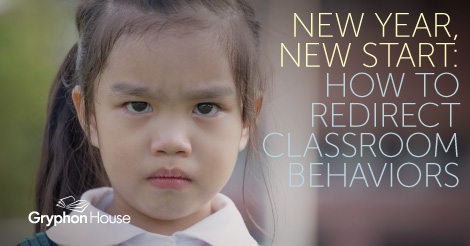New Year, New Start: How to Redirect Classroom Behaviors
January 10th, 2017 | 4 min. read
By Anna Wilmoth


It’s January; that means the school year is halfway over! However, if the children in your classroom are still exhibiting challenging behaviors, it can feel like you’re running out of time to make an impact. Early childhood educators have the unique position of teaching children how to behave in public as well as how to learn in a classroom. Normally we expect behaviors such as biting, shouting, and kicking to disappear within the first few months of school, but this isn’t always the case. If children are still misbehaving, teachers may need some more creative resources for the early childhood classroom.
That’s where William DeMeo comes in. His book, When Nothing Else Works: What Early Childhood Professionals Can Do to Reduce Challenging Behaviors contains multiple ways to approach problematic behavior, from transition activities to classroom management strategies. Each chapter presents a different variable that influences child behavior and provides strategies for how to fix it. Even with only half a year to go, educators still have time to remedy negative behavior and give the classroom a fresh start. Here are some ways to make removing problem behavior your new year’s resolution.
Trust-Driven Problem Behaviors
When young children act out, it can be easy to interpret their behavior as a lack of respect for the teacher. Educators shouldn’t take it personally, however; most preschool-age children don’t misbehave out of rebellion. It’s more likely the child is uncomfortable at school or simply does not trust the teacher or other students. While this is common behavior when children first start school, it becomes more of an issue if it continues later in the year. In that case, a more deep-seated distrust may be in place. Trust is a big deal in early childhood. Since children this age are so dependent on others, the risk of feeling vulnerable is very high. Young children who suffer from separation anxiety or insecure attachment styles may view the classroom as a scary place full of people they fear won’t protect them.
While teachers do all they can to make a child feel safe and protected, there comes a point where trust of the teacher is not enough. Children in a classroom need to trust each other as well. After all, there are more students than there are teachers. To build trust between students, teachers can implement trust-building exercises that will break down some of the animosity between students. Here are a few suggestions:
Sculpturing: This game has one child act like “clay” while the other child moves the first’s limbs into the shape of a letter of the alphabet. This game not only promotes early literacy, but encourages children to communicate with one another while demonstrating a positive touch.
Back Art: Here, children stand in a line and use one another’s backs as canvases while they draw. Each child places a piece of paper against the back of the person in front of them and then draws on it standing up. It promotes trust as well as teamwork since each person must stand very still to be drawn on. The feel of the markers across their backs may also be a comforting sensation for some children.
Mirroring: The mirroring activity provides practice for self-regulation since the person being the “mirror” must follow the instructions of the person in front of them. Conversely, the person who makes up the movements receives the comforting experience of having somebody listen to them through mimicry. This simple idea—that another student is willing to listen and do what the first student wants—is very powerful, especially for children who are seeking acknowledgement and inclusion.
Emotion-Driven Problem Behaviors
By the second half of the school year, teachers know their students pretty well. They can tell when they are upset or acting out of character. This is an important step in the teacher-student relationship because it makes it easier to employ active listening. If a child comes in and is visibly angry, throwing his backpack on the ground and kicking his chair, the teacher will most likely attempt to find out what’s wrong. The words “I know you are upset” are very, very effective; they let the child know you understand and empathize with their emotions rather than accusing or blaming them. This phrase is often the first step to dealing with emotion-driven behavior.
If a child consistently displays negative behavior out of anger and frustration, it is best to take the time to find out where this aggression is coming from. Often, children will tell an adult what’s bothering them, just not always verbally. Body language and actions give educators clues as to what the real problem is. Say, for example, a child is sitting in circle time and raising her hand to answer a question. When the boy next to her gets called on, she gets angry and hits him. In this situation, a teacher or teaching assistant should take the child aside and say, “I saw you get upset and hit Bobby. Why did you hit him?” to which the child may respond with, “No one listens to me. It was my turn!” The source of the tension has been found, but to treat it, the conversation should continue: “Did you feel left out of the discussion? Why don’t we read a book about fairness and taking turns, and then come up with a different way you could have been included?” This gives the child some input on how the change in behavior will go while still acknowledging and validating her feelings.
Motor and Sensory-Driven Problem Behaviors
If every other cause of a behavior has been addressed and the child still has not stopped, the behavior may be due to some sort of sensory need. Children who bite without provocation may have a need to chew on something, and children who struggle to sit still or leave things alone may have an irrepressible urge to squirm or move their hands. In this case, special accommodations can be made by the educator to treat the child’s needs in a way that will not disrupt the class.
For sensory needs, special toys called fidgets are the best option for treatment. Fidget toys can be squeezed, bent, or chewed depending on the design. Children can use them during activities like circle time or nap time in order to stay focused and quiet; having something that fulfills their sensory need actually improves focus rather than presenting a distraction. For tactile fidgets, stress balls, necklaces, a slinky, or bubble wrap can be used, but not every texture will work for each child. That’s why it’s best to present a fidgety child with multiple toys they can test out and see which one fulfills their needs the best.
Motor-need behaviors may be more familiar. These students want to concentrate on the lesson at hand, but they feel the need to move and squirm, which can be distracting to other children. Unlike with sensory needs, however, these movements cannot be limited to squeezing or chewing an object, and the children often don’t realize they are doing it. To treat these behaviors, teachers can give squirming children weighted stuffed animals to hold in their laps during sit-down activities. These stuffed animals are usually filled with sand or some other heavy material, and the weight makes children more aware of the movement and helps keep it from happening. Another option is to have “wiggle seats”—chairs and seats that move like rocking or beanbag chairs—at certain areas in the classroom for activities like reading. These seats provide children a controlled way to move that is not disruptive to the classroom.
Problem behaviors don’t have to continue long into the New Year. With a bit of patience and some new techniques, educators can learn to prevent and treat behaviors and create a better classroom environment.
Author(s)William DeMeo
Marketer. Publisher. Reporter. Educator. Mother. Runner. Explorer. Anna served as director of marketing for Gryphon House from Oct 2014 - May 2017.
Topics: